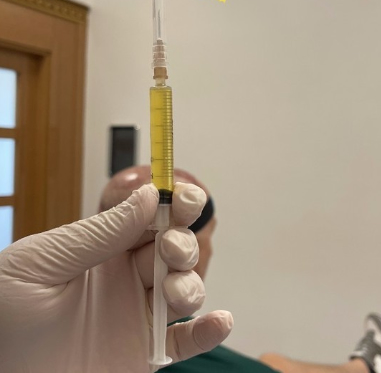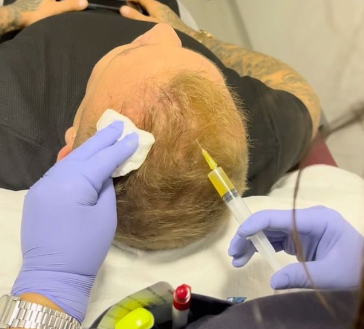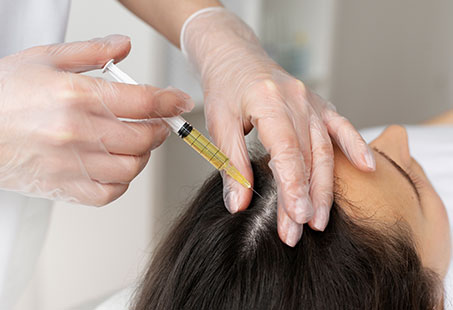One of the most common non-surgical and non-invasive solutions to hair loss is platelet-rich plasma. However, there’s a so-called “second generation” of PRP, known as platelet-rich fibrin or PRF.
It is believed to help with hair growth, just like PRP. In fact, it is considered more effective. But then, why is it not as popular as PRP itself? There are more than a few reasons, such as lack of sufficient evidence on effectiveness, novelty, and inaccessibility. Also, depending on the type of hair loss you have, it might not work at all.
What Is PRF For Hair Loss?
Platelet-rich fibrin, or PRF, is considered an advanced form of PRP. It contains white blood cells, platelets, stem cells, cytokines, and growth factors held together in a fibrin membrane or clot. Fibrin itself is a protein which helps in the blood clotting process (it’s part of the blood clot).
The proteins and growth factors in PRF work by stimulating the wound-healing process. The undifferentiated stem cells further add to their potential of regenerating the hair follicle and the hair itself. It even has growth factors that can help in the formation of new blood vessels. This way, the hair follicles can get more oxygen and nutrients from the blood.
Obtaining the PRF is a relatively simple process that does not require the addition of any biochemicals like anticoagulants (to prevent the blood from clotting). And that has been made possible because of the time and speed at which the blood is centrifuged.
Types of PRF
It should be noted that there are different types of PRFs based on how they’re prepared. Originally, PRF was created by spinning the blood in the centrifuge machine for 12 minutes at 2,700 rpm (revolutions per minute). However, now, it has the following types:
- Advanced PRF (A-PRF) – It was prepared by rotating the blood at 1,300 rpm for 14 minutes. The benefit of this was that it damaged fewer cells (due to less force). It also had more white blood cells and platelets.
- Advanced PRF Plus (A-PRF+) – While the rpm was kept the same, the time was lowered to 8 minutes to prepare the A-PRF+. Consequently, the obtained mixture had more growth factors in it.
- Injectable PRF (i-PRF) – When it comes to the use of PRF for hair loss, it is i-PRF that’s used. That is because it is in liquid form, and as the name indicates, it can be “injected” (the others are gels). This is prepared by spinning the blood at 700 rpm for 3 minutes.
The differences in preparation allowed for different types of PRFs to be created that are all used for different purposes.
What Is The Procedure For i-PRF Treatment For Hair Loss?
Once you arrive at the clinic, your practitioner will begin by drawing blood. The tube which contains the blood is then placed into a centrifuge machine for 3 minutes. As a result, a reddish-yellow liquid will separate at the top of the tube.

This yellowish liquid contains platelet-rich fibrin. It is then injected into different areas of the scalp (2-4mm deep) that are balding. Local anaesthesia is not needed as PRF injections do not cause pain.

The entire session won’t take longer than 10-15 minutes. However, keep in mind that you’ll probably need more than one session. Usually, people end up getting 1 injection per month for 2-3 months. Afterwards, they can get maintenance injections to keep seeing the results. Some clinics also combine PRF with derma-rolling to further improve the results.
What Is The Recovery Process After PRF Hair Loss Treatment?
Since PRF is prepared using the patient’s blood, it will not cause any serious side effects. You may have some redness and bruising for a couple of days, but that should resolve. You won’t see any results immediately after the PRF treatment. Most people see the results after 3-4 sessions.
Meanwhile, soon after the treatment, you may be advised against washing your head for at least 24 hours. Additionally, you might have to avoid swimming, hot saunas and baths for some time. Lastly, you will have to protect your scalp against direct sunlight and dust.
PRP vs PRF: What’s The Difference?
Understanding the differences between PRF and PRP will give you an idea of which one’s better.
Composition
PRF and PRP differ primarily in their composition. PRP contains a concentration of platelets in plasma. It also contains growth factors that help stimulate hair growth. But PRF is like PRP on steroids.
It contains far more growth factors, white blood cells, cytokines, and even stem cells (which are being used separately to do stem cell hair transplants). Therefore, when injected, PRF will be more beneficial for your hair.
As mentioned above, their composition is different because of the way they’re prepared. In PRP, the rpm is usually more than 2,000, so the force is greater. As a result, many of the components of the blood are absent from the platelet-rich plasma. Even some platelets don’t make it to that mix.
However, since the speed is slower in the making of PRF, it ends up retaining many more components of the blood. It also doesn’t cause as much damage to the cells. This can end up benefitting hair growth.
Preparation
It’s easier to prepare PRF compared to PRP. In PRP, anticoagulants are added to make sure that the blood doesn’t clot while it’s being processed. The addition of anticoagulants, although necessary, can somewhat hinder the process of wound healing.
On the other hand, no anticoagulants are needed in the preparation of i-PRF. In fact, it can stay in its liquid form for 15 minutes after it has been prepared. And the added advantage of it is that the fibrin mesh forms inside the scalp once it has been injected (that serves another purpose). Therefore, not using any biochemicals makes the preparation of PRF easier.
Diffusion
After it’s injected into the scalp, fibrin clots form, which prevents growth factors, white blood cells, and stem cells from diffusing to other parts of the scalp. The fibrin helps keep the “good stuff” in the place that needs it most. It acts as a scaffold. Because of fibrin, PRF can keep releasing growth for days after it has been injected (which doesn’t happen in the case of PRP).
However, PRP, on the other hand, does not contain any fibrin. There’s nothing holding it in place, so it has the potential to diffuse or spread to other areas of the scalp. However, that’s not always a bad thing.
In fact, practitioners slightly massage the scalp after each injection to spread the injection so that the surrounding hair can also benefit. However, if the hair loss only occurs in the crown area, it is best for that region to have the maximum growth factors.
Cost
As far as the cost is concerned, there’s not much of a difference. It’s possible that, in some areas, PRF is cheaper than PRP. This could possibly be due to the easier preparation process. On average, though, a single injection of PRF usually starts from £300-400. A single session of PRP usually starts from £400.
But keep in mind that you’ll need multiple sessions of these treatments, so PRF will end up costing you around £1,500 for 4 sessions. In contrast, PRP will cost you a couple of hundred pounds more.
Summarizing Differences
Following is a summary of the differences between PRP and PRF
| PRP | PRF | |
| Composition | Contains platelets, proteins, growth factors, and water | Contains white blood cells, stem cells, cytokines, fibrin, and platelets |
| Preparation | 2,000+ rpm for 1o minutes | 700 rpm for 3 minutes |
| Added Biochemicals | Anticoagulants to prevent the blood from clotting in the tube | Stays in liquid form for 15 minutes |
| Diffusion | Can easily spread to the surrounding areas. | The fibrin clot concentrates the white blood cells, stem cells, platelets, etc. in one area |
| Cost | Comparable to PRF Cost of one session usually starts from £250 | Maybe slightly cheaper than PRP Cost of one session usually starts from £300-400 |
What Are The Shortcomings Of PRF For Hair Loss?
On paper, everything about PRF seems well and good, only there are a few problems:
Limited Evidence On Effectiveness
There is very limited evidence that PRF works for hair loss. Since PRF is a more advanced form of PRP, which has been proven to treat hair loss in many studies, it is expected that it will be equally effective. However, so far, there are only case reports of it.
A case report on three patients with androgenetic alopecia treated with i-PRF has been published in the International Journal of Trichology. Of these 3 patients, two of them had extensive hair loss (Norwood Stage 6 and 7). I-PRF didn’t prove to be as effective for those patients. Although, better results were seen in the patient who hadn’t lost much hair.
Other than that, there has been a case report of PRF working well for a patient who had lost hair due to COVID-induced alopecia areata. It may be recommended for rejuvenation of the scalp or to promote growth after temporary hair loss. It remains true, however, that there is very little evidence on how well it works for hair.
May Not Work
Research on PRF for hair loss is limited to those who have androgenetic alopecia or alopecia areata, and that’s still in its infancy. There are different types of alopecia, and there’s no guarantee that PRF will work for them.
As far as PRP is concerned, there’s increasing evidence of its effectiveness for androgenetic alopecia (temporarily), alopecia areata, traction alopecia, and even scarring alopecia like frontal fibrosing alopecia and lichen planopilars. Therefore, make sure to do your research and consult a medical professional before you decide to have PRF therapy for hair loss.
Recently Introduced
It’s true that the first PRF injection was prepared in 2001, but that was for dentistry, not hair loss. The i-PRF injections (that are actually injected into the hair) only came around in 2015. So, it’s very new.
On the other hand. PRP therapy has been considered for hair loss since 2006. It’s been around almost a decade more than PRF, so it’s time-tested. Much has been researched about it since, and there are many studies proving its effectiveness for different types of alopecia.
In fact, it’s even recommended as an adjunct treatment after a hair transplant to further improve the results. The same cannot be said for PRF.
Poor Accessibility
Since i-PRF is fairly new, you won’t find many clinics offering it. It’s not widely available. And you have to do your research to make sure that clinics aren’t selling PRP under the garb of PRF. Marketed as the “advanced form of PRP,” you could end up being charged more for it.
Conclusion
PRF hair loss treatment sounds very promising, but it requires more research. Since its composition is more complex, it isn’t exactly understood how it can work to promote hair growth.
Long-term, large sample-size studies are needed on it. On the other hand, PRP has been around for quite a while and has proven to be quite effective for different types of alopecia.
However, whether it’s PRP or PRF, keep in mind that they cannot treat or cure pattern baldness.
For any improvements you notice, you will need maintenance injections. Also, both of them are contraindicated in certain cases, so make sure to discuss everything with a medical professional.


